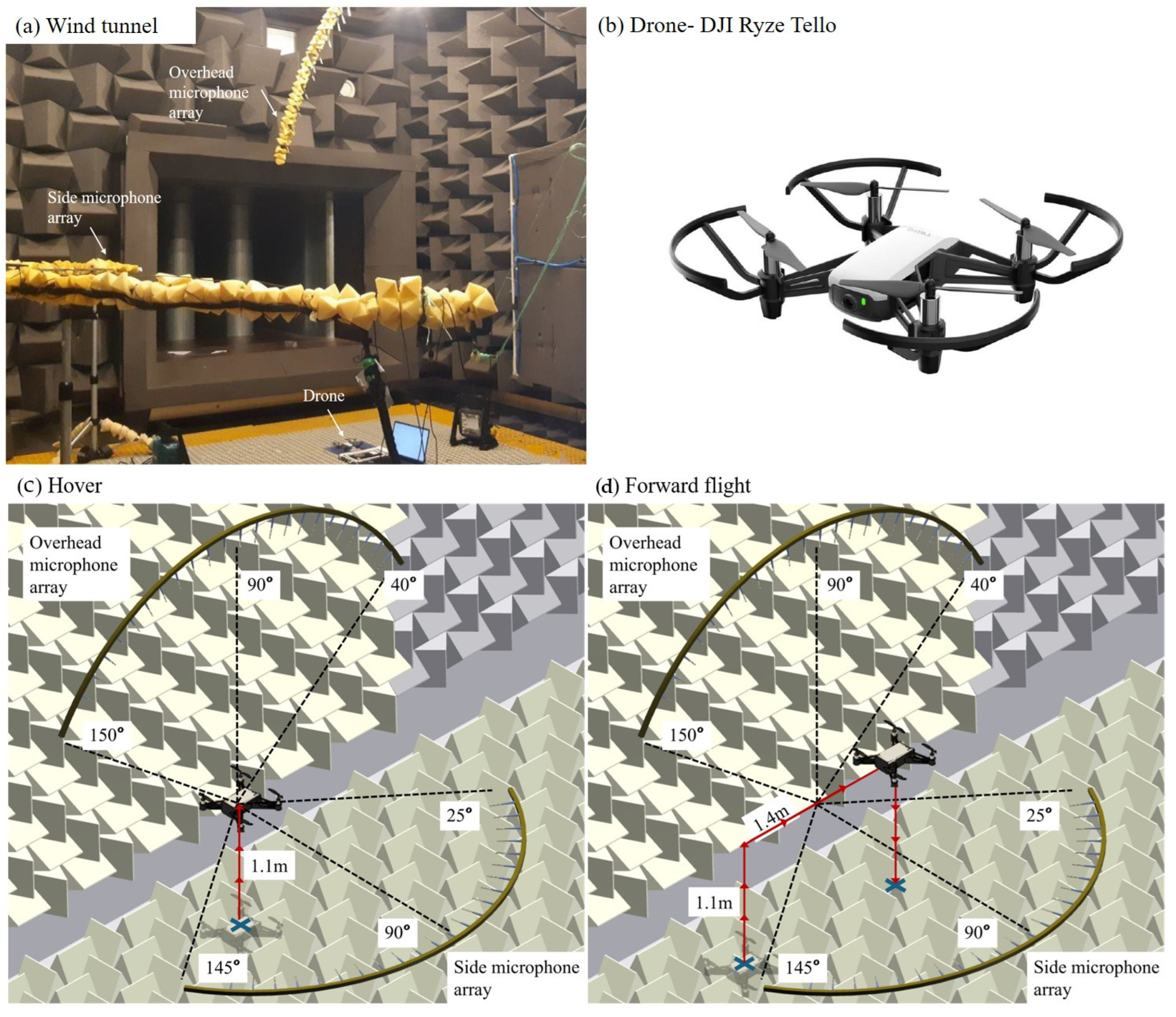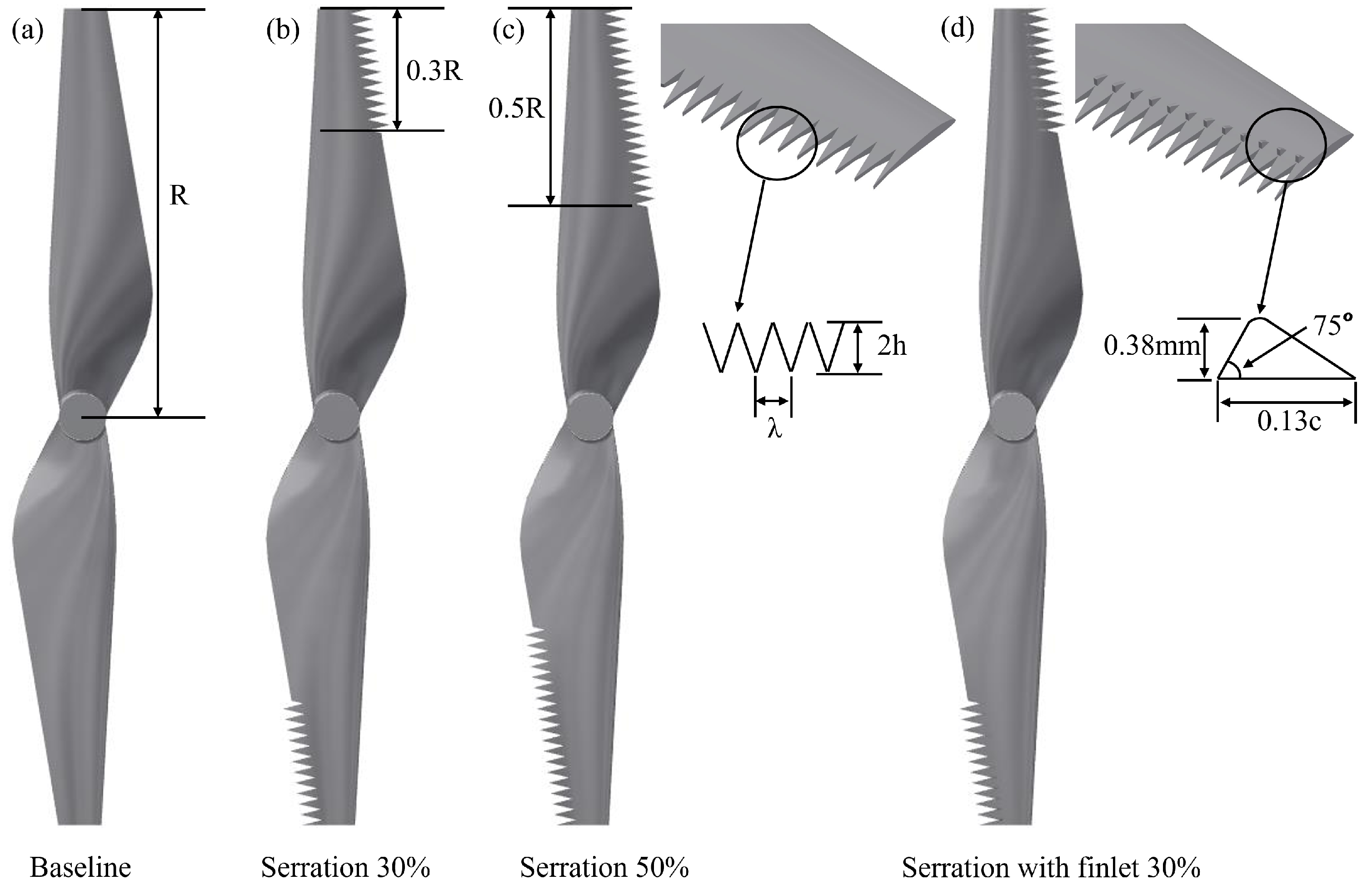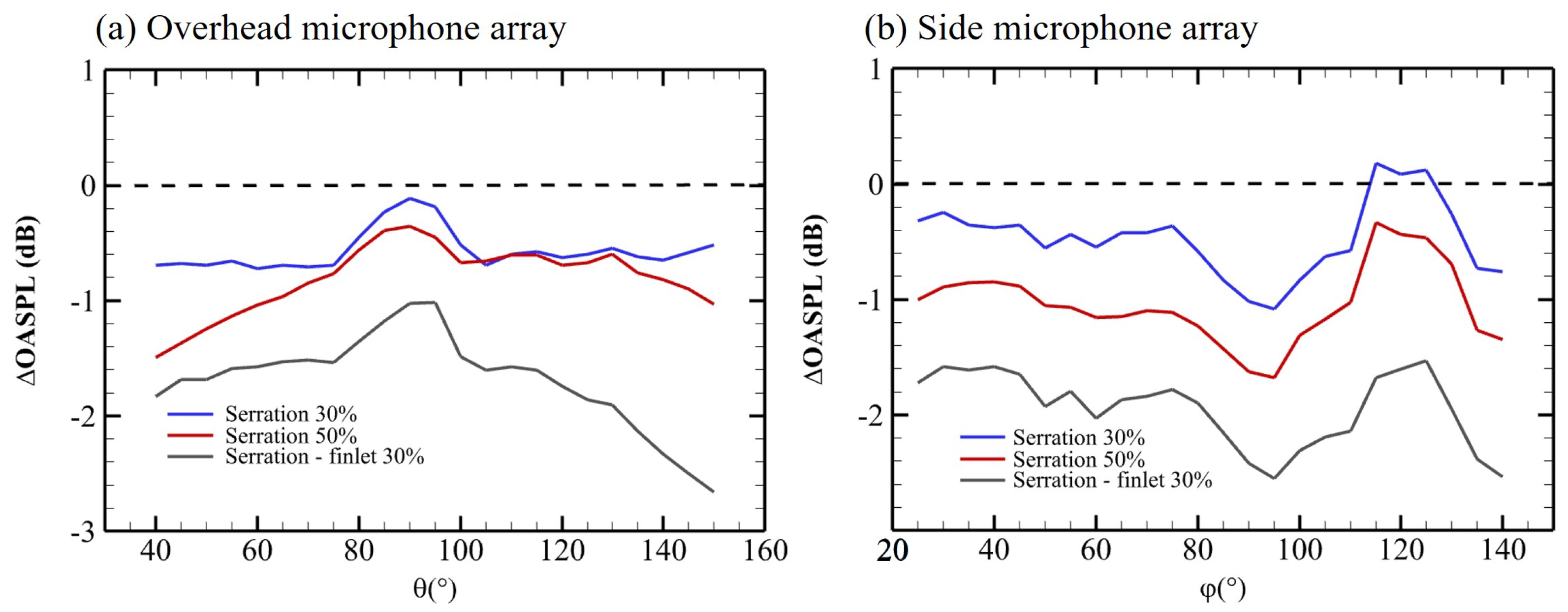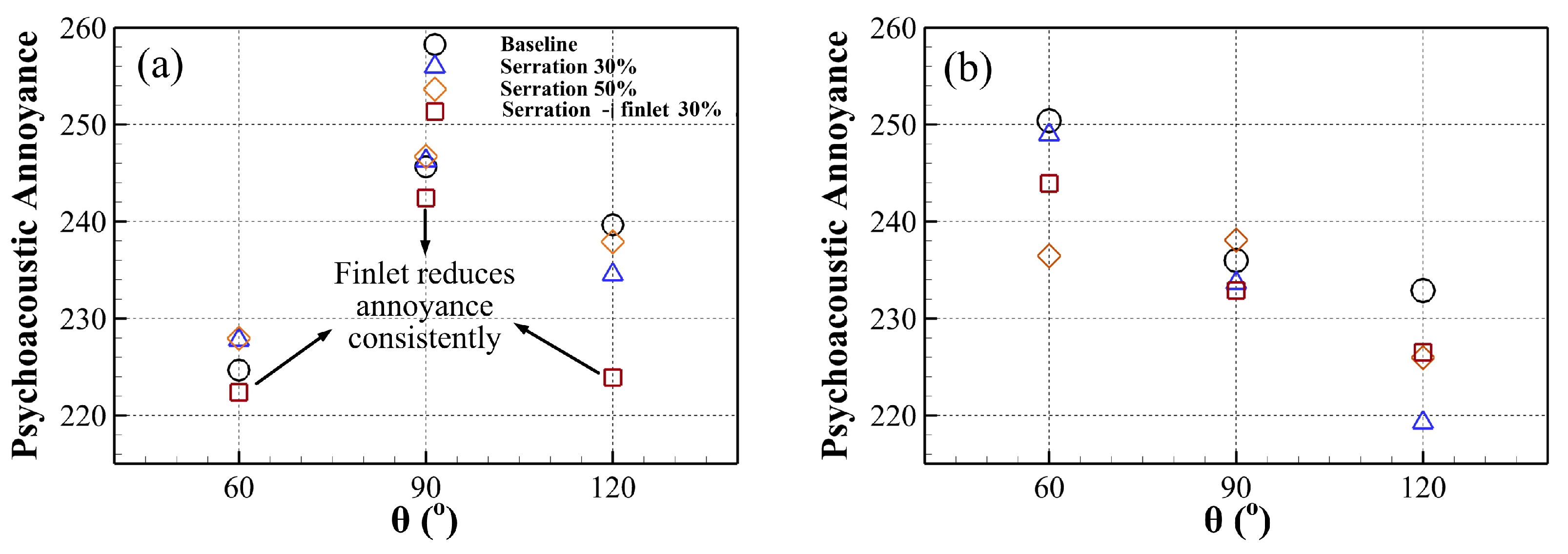Drone Noise Reduction Using Serration–Finlet Blade Design and Its Psychoacoustic and Social Impacts
Abstract
1. Introduction
2. Methodology
2.1. Experimental Facility and Operating Conditions
2.2. Baseline Blade and Serration–Finlet Modifications
2.3. Acoustic and Psychoacoustic Post-Processing
3. Results and Discussion
3.1. Far-Field Acoustic Characteristics in Hover and Forward Flight Conditions
3.2. Psychoacoustic Annoyance Analysis for Different Rotor Blades
3.3. Brief Discussion on Social Impact
4. Conclusions
Author Contributions
Funding
Institutional Review Board Statement
Informed Consent Statement
Data Availability Statement
Acknowledgments
Conflicts of Interest
References
- Elsayed, M.; Mohamed, M. The impact of airspace regulations on unmanned aerial vehicles in last-mile operation. Transp. Res. Part D Transp. Environ. 2020, 87, 102480. [Google Scholar] [CrossRef]
- Ramos-Romero, C.; Green, N.; Roberts, S.; Clark, C.; Torija, A.J. Requirements for drone operations to minimise community noise impact. Int. J. Environ. Res. Public Health 2022, 19, 9299. [Google Scholar] [CrossRef]
- Passchier-Vermeer, W.; Passchier, W.F. Noise exposure and public health. Environ. Health Perspect. 2000, 108, 123–131. [Google Scholar] [PubMed]
- Münzel, T.; Sørensen, M.; Daiber, A. Transportation noise pollution and cardiovascular disease. Nat. Rev. Cardiol. 2021, 18, 619–636. [Google Scholar] [CrossRef] [PubMed]
- Çetin, E.; Cano, A.; Deransy, R.; Tres, S.; Barrado, C. Implementing mitigations for improving societal acceptance of urban air mobility. Drones 2022, 6, 28. [Google Scholar] [CrossRef]
- Doolan, C.; Yauwenas, Y.; Moreau, D. Drone propeller noise under static and steady inflow conditions. In Flinovia—Flow Induced Noise and Vibration Issues and Aspects-III; Springer: Cham, Switzerland, 2019; pp. 45–60. [Google Scholar]
- Zawodny, N.S.; Christian, A.; Cabell, R. A summary of NASA research exploring the acoustics of small unmanned aerial systems. In Proceedings of the AHS Technical Meeting on Aeromechanics Design for Transformative Vertical Flight, San Francisco, CA, USA, 16–19 January 2018. Report Number: NF1676L-27827. [Google Scholar]
- Cabell, R.; Grosveld, F.; McSwain, R. Measured noise from small unmanned aerial vehicles. In Proceedings of the Inter-Noise and Noise-Con Congress and Conference Proceedings, Providence, RI, USA, 13–15 June 2016; Volume 252, pp. 345–354. [Google Scholar]
- Zhang, Y.; Lee, I.; Lin, D. Measurement of noise from a moving drone using a phased array microphone system. In Proceedings of the 2017 Asia-Pacific International Symposium on Aerospace Technology, Seoul, Republic of Korea, 3–9 June 2017; pp. 16–18. [Google Scholar]
- Zawodny, N.; Pettingill, N. Acoustic wind tunnel measurements of a quadcopter in hover and forward flight conditions. In Proceedings of the INTER-NOISE and NOISE-CON Congress and Conference Proceedings, Chicago, IL, USA, 26–29 August 2018; Volume 258, pp. 487–500. [Google Scholar]
- Zhou, T.; Jiang, H.; Huang, B. Quad-copter noise measurements under realistic flight conditions. Aerosp. Sci. Technol. 2022, 124, 107542. [Google Scholar] [CrossRef]
- Wei, Z.; Wang, S.; Farris, S.; Chennuri, N.; Wang, N.; Shinsato, S.; Demir, K.; Horii, M.; Gu, G.X. Towards silent and efficient flight by combining bioinspired owl feather serrations with cicada wing geometry. Nat. Commun. 2024, 15, 4337. [Google Scholar] [CrossRef]
- Avallone, F.; Pröbsting, S.; Ragni, D. Three-dimensional flow field over a trailing-edge serration and implications on broadband noise. Phys. Fluids 2016, 28, 117101. [Google Scholar] [CrossRef]
- Liu, X.; Kamliya Jawahar, H.; Azarpeyvand, M.; Theunissen, R. Aerodynamic performance and wake development of airfoils with serrated trailing-edges. AIAA J. 2017, 55, 3669–3680. [Google Scholar] [CrossRef]
- Howe, M.S. Noise produced by a sawtooth trailing edge. J. Acoust. Soc. Am. 1991, 90, 482–487. [Google Scholar] [CrossRef]
- Lyu, B.; Azarpeyvand, M.; Sinayoko, S. Prediction of noise from serrated trailing edges. J. Fluid Mech. 2016, 793, 556–588. [Google Scholar] [CrossRef]
- Ning, Z.; Wlezien, R.W.; Hu, H. An experimental study on small UAV propellers with serrated trailing edges. In Proceedings of the 47th AIAA Fluid Dynamics Conference, Denver, CO, USA, 5–9 June 2017; pp. 2017–3813. [Google Scholar]
- Yang, Y.; Wang, Y.; Liu, Y.; Hu, H.; Li, Z. Noise reduction and aerodynamics of isolated multi-copter rotors with serrated trailing edges during forward flight. J. Sound Vib. 2020, 489, 115688. [Google Scholar] [CrossRef]
- Zang, B.; Hanson, L.P.; Stoltz, A.; Ho, W.H.; Liu, X.; Azarpeyvand, M. Numerical and experimental investigation of propeller noise with trailing-edge serrations. In Proceedings of the AIAA AVIATION 2023 Forum, San Diego, CA, USA, 12–16 June 2023; pp. 2023–3835. [Google Scholar]
- Shi, Y.; Kollmann, W. Wall-modeled large-eddy simulation of a trailing-edge serration-finlet configuration. AIP Adv. 2021, 11, 065222. [Google Scholar] [CrossRef]
- Torija, A.J.; Clark, C. A psychoacoustic approach to building knowledge about human response to noise of unmanned aerial vehicles. Int. J. Environ. Res. Public Health 2021, 18, 682. [Google Scholar] [CrossRef]
- Di, G.Q.; Chen, X.W.; Song, K.; Zhou, B.; Pei, C.M. Improvement of Zwicker’s psychoacoustic annoyance model aiming at tonal noises. Appl. Acoust. 2016, 105, 164–170. [Google Scholar] [CrossRef]
- Torija, A.J.; Li, Z.; Chaitanya, P. Psychoacoustic modelling of rotor noise. J. Acoust. Soc. Am. 2022, 151, 1804–1815. [Google Scholar] [CrossRef]
- DJI. Tello User Manual. 2018. Available online: https://dl-cdn.ryzerobotics.com/downloads/Tello/Tello%20User%20Manual%20v1.4.pdf (accessed on 23 December 2024).
- Glegg, S.; Devenport, W. Aeroacoustics of Low Mach Number Flows: Fundamentals, Analysis, and Measurement; Academic Press: Cambridge, MA, USA, 2017. [Google Scholar]
- Gori, Y.; Patil, P.P.; Taluja, R. UAV structure and aerodynamic character research on two different airfoils. Webology 2021, 18, 1418–1428. [Google Scholar]
- Van Treuren, K.; Wisniewski, C. The importance of airfoil selection in the design of UAS propellers. In Proceedings of the Turbo Expo: Power for Land, Sea, and Air, Rotterdam, Rotterdam, The Netherlands, 13–17 June 2022; American Society of Mechanical Engineers: New York, NY, USA, 2022; Volume 85970, p. V001T01A011. [Google Scholar]
- Rizzi, S. Toward reduced aircraft community noise impact via a perception-influenced design approach. In Proceedings of the Inter-Noise Congress and Conference Proceedings, Hamburg, Germany, 21–24 August 2016; Volume 253, pp. 220–244. [Google Scholar]
- Torija, A.J.; Roberts, S.; Woodward, R.; Flindell, I.H.; McKenzie, A.R.; Self, R.H. On the assessment of subjective response to tonal content of contemporary aircraft noise. Appl. Acoust. 2019, 146, 190–203. [Google Scholar] [CrossRef]
- Boucher, M.A.; Krishnamurthy, S.; Christian, A.W.; Rizzi, S.A. Sound quality metric indicators of rotorcraft noise annoyance using multilevel analysis. J. Acoust. Soc. Am. 2023, 153, 867–876. [Google Scholar] [CrossRef]
- Green, N.; Torija, A.J.; Ramos-Romero, C. Perception of noise from unmanned aircraft systems: Efficacy of metrics for indoor and outdoor listener positions. J. Acoust. Soc. Am. 2024, 155, 915–929. [Google Scholar] [CrossRef]
- Greco, G.; Merino-Martinez, R.; Osses, A. SQAT: A Sound Quality Analysis Toolbox for MATLAB (Version v1. 1). 2023. Available online: https://zenodo.org/records/10580337 (accessed on 23 December 2024).
- Greco, G.F.; Merino-Martínez, R.; Osses, A.; Langer, S.C. SQAT: A MATLAB-based toolbox for quantitative sound quality analysis. In Proceedings of the Inter-Noise and Noise-Con Congress and Conference Proceedings, Chiba, Japan, 20–23 August 2023; Volume 268, pp. 7172–7183. [Google Scholar]
- Osses, A.; Greco, G.F.; Merino-Martínez, R. Considerations for the perceptual evaluation of steady-state and time-varying sounds using psychoacoustic metrics. In Proceedings of the Forum Acusticum, Torino, Italy, 11–15 September 2023. [Google Scholar]
- ISO532-3: 2023; Acoustics—Methods for Calculating Loudness—Part 3: Moore-Glasberg-Schlittenlacher. International Organization for Standardization: Geneva, Switzerland, 2023.
- DIN 45692; Measurement Technique for the Simulation of the Auditory Sensation of Sharpness. Deutsches Institut für Normung: Berlin, Germany, 2009.
- Aures, W. Berechnungsverfahren für den sensorischen Wohlklang beliebiger Schallsignale (A model for calculating the sensory euphony of various sounds). Acta Acust. United Acust. 1985, 59, 130–141. [Google Scholar]
- Zwicker, E.; Fastl, H. Psychoacoustics: Facts and Models; Springer Series in Information Sciences Volume 22; Springer Science & Business Media: Berlin/Heidelberg, Germany, 2013. [Google Scholar]
- Brooks, T.F.; Jolly, J.R., Jr.; Marcolini, M.A. Helicopter Main-Rotor Noise: Determination of Source Contributions Using Scaled Model Data; Technical Report; NASA Langley Research Centre: Hampton, VA, USA, 1988; Report Number: NASA-TP-2825. [Google Scholar]
- Intaratep, N.; Alexander, W.N.; Devenport, W.J.; Grace, S.M.; Dropkin, A. Experimental study of quadcopter acoustics and performance at static thrust conditions. In Proceedings of the 22nd AIAA/CEAS Aeroacoustics Conference, Lyon, France, 30 May–1 June 2016. Article Number: 2016-2873. [Google Scholar]
- Jamaluddin, N.S.; Celik, A.; Baskaran, K.; Rezgui, D.; Azarpeyvand, M. Aerodynamic noise analysis of tilting rotor in edgewise flow conditions. J. Sound Vib. 2024, 582, 118423. [Google Scholar] [CrossRef]
- Glauert, H. Airplane Propellers. In Aerodynamic Theory: A General Review of Progress; Springer: Berlin/Heidelberg, Germany, 1935; pp. 169–360. [Google Scholar]
- Avallone, F.; Van Der Velden, W.C.P.; Ragni, D.; Casalino, D. Noise reduction mechanisms of sawtooth and combed-sawtooth trailing-edge serrations. J. Fluid Mech. 2020, 848, 560–591. [Google Scholar] [CrossRef]
- Hollander, M.; Wolfe, D.A.; Chicken, E. Nonparametric Statistical Methods; John Wiley & Sons Inc.: Hoboken, NJ, USA, 2013. [Google Scholar]
- Torija, A.J.; Nicholls, R.K. Investigation of metrics for assessing human response to drone noise. Int. J. Environ. Res. Public Health 2022, 19, 3152. [Google Scholar] [CrossRef]
- Gu, L.M. Innovation chain driving the integrated development of emerging industries: Theoretical logic and mechanism design. Mod. Econ. Discuss. 2024, 3, 80–86. [Google Scholar] [CrossRef]
- Li, C.J.; Ma, J.; Chai, Y.W.; Guan, M.B. Influence of neighborhood environment and noise pollution on residents’ mental health in Beijing. Prog. Geogr. 2019, 38, 1103–1110. [Google Scholar]
- Luo, J.; Zhu, K. The influential factors on the attraction of outstanding scientific and technological talents in developed cities in China. Sustainability 2023, 15, 6214. [Google Scholar] [CrossRef]









| Anechoic chamber (m3) | 7 (L) × 4.5 (W) × 3.5 (H) |
| Microphone | GRAS 40PL free field |
| DAQ system | NI PXIe-1082 chassis with NI PXIe-4499 |
| Overhead arc radius (m) | 1.75 |
| Overhead arc polar (°) | to ( interval) |
| Side arc radius (m) | 2.2 |
| Side arc polar (°) | to ( interval) |
| Mass (kg) | 0.08 |
| Dimensions (m) | 0.098 × 0.092 × 0.041 |
| Rotor Diameter (m) | 0.762 |
| Number of motors | 4 |
| Number of rotor blade | 2 |
| Flight control | Visual Positioning System |
| Flight Program | Python-based (version 3.10) Tello programming |
| Parameter | R (m) | (m) | (m) | Number of Blades | Nominal RPM in Hover | Reynolds Number at |
|---|---|---|---|---|---|---|
| 0.0381 | 0.00825 | 0.00619 | 2 | 16,000 |
| Blade Design | BPF (Hz) | RPM | Percentage Difference (%) |
|---|---|---|---|
| Baseline | 540 | 16,200 | - |
| Serration 30% | 552 | 16,560 | 2.2 |
| Serration 50% | 552 | 16,560 | 2.2 |
| Serration–finlet 30% | 548 | 16,440 | 1.5 |
| Loudness | Sharpness | Tonality | Psychoacoustic Annoyance | |
|---|---|---|---|---|
| Loudness | - | - | - | 0.9436 |
| Sharpness | - | - | 0.4530 | |
| Tonality | - | 0.3051 | ||
| Psychoacoustic Annoyance | - |
| Loudness | Sharpness | Tonality | Psychoacoustic Annoyance | |
|---|---|---|---|---|
| Loudness | - | - | - | 0.9268 |
| Sharpness | - | - | 0.0766 | |
| Tonality | - | 0.4577 | ||
| Psychoacoustic Annoyance | - |
| Average OASPL Reduction (dB) | Average Psychoacoustic Annoyance Reduction (%) | |||
|---|---|---|---|---|
| Hover | Forward | Hover | Forward | |
| Baseline | - | - | - | - |
| Serration 30% | 0.57 | 0.91 | 0 | 3.35 |
| Serration 50% | 0.83 | 1.16 | −0.49 | 2.49 |
| Serration–finlet 30% | 1.69 | 1.35 | 2.98 | 6.32 |
Disclaimer/Publisher’s Note: The statements, opinions and data contained in all publications are solely those of the individual author(s) and contributor(s) and not of MDPI and/or the editor(s). MDPI and/or the editor(s) disclaim responsibility for any injury to people or property resulting from any ideas, methods, instructions or products referred to in the content. |
© 2025 by the authors. Licensee MDPI, Basel, Switzerland. This article is an open access article distributed under the terms and conditions of the Creative Commons Attribution (CC BY) license (https://creativecommons.org/licenses/by/4.0/).
Share and Cite
Shen, Y.; Bai, Y.; Liu, X.; Zang, B. Drone Noise Reduction Using Serration–Finlet Blade Design and Its Psychoacoustic and Social Impacts. Sustainability 2025, 17, 3451. https://doi.org/10.3390/su17083451
Shen Y, Bai Y, Liu X, Zang B. Drone Noise Reduction Using Serration–Finlet Blade Design and Its Psychoacoustic and Social Impacts. Sustainability. 2025; 17(8):3451. https://doi.org/10.3390/su17083451
Chicago/Turabian StyleShen, Yingyin, Yuanqing Bai, Xiao Liu, and Bin Zang. 2025. "Drone Noise Reduction Using Serration–Finlet Blade Design and Its Psychoacoustic and Social Impacts" Sustainability 17, no. 8: 3451. https://doi.org/10.3390/su17083451
APA StyleShen, Y., Bai, Y., Liu, X., & Zang, B. (2025). Drone Noise Reduction Using Serration–Finlet Blade Design and Its Psychoacoustic and Social Impacts. Sustainability, 17(8), 3451. https://doi.org/10.3390/su17083451







